Automating a Dehazing System by Self-Calibrating on Haze Conditions
Abstract
:1. Introduction
- An automated scheme is proposed where image dehazing is combined with an HDE to dehaze the input image regardless of the presence of haze.
- Efficient image processing techniques are utilized, such as multiscale fusion, image blending, and tone remapping, to produce satisfactory results.
- A comparative evaluation is performed with well-publicized benchmark methods to demonstrate the efficacy of the proposed AUDS.
2. Literature Review
2.1. Hazy Image Formation
2.2. Related Work
2.3. Motivation
3. Proposed System
3.1. HDE
3.2. Dehazing Using Under-Exposure and Image Fusion
3.3. Image Blending
- An input image if the haze condition is “haze-free”.
- A dehazed image if the haze condition is “densely hazy”.
- A linear combination of the input image and its dehazed version if the haze condition is either “mildly hazy” or “moderately hazy”.
- The blended result is the input image if .
- The blended result is the dehazed image if .
- The blended result is a linear combination of these two images if .
3.4. Tone Remapping
4. Experimental Results
4.1. Parameter Configuration
4.2. Qualitative Comparison of Hazy Images
4.3. Qualitative Comparison of Haze-Free Images
4.4. Quantitative Comparison
4.5. Run-Time Comparison
5. Conclusions
Author Contributions
Funding
Institutional Review Board Statement
Informed Consent Statement
Data Availability Statement
Conflicts of Interest
References
- Pei, Y.; Huang, Y.; Zou, Q.; Zhang, X.; Wang, S. Effects of Image Degradation and Degradation Removal to CNN-based Image Classification. IEEE Trans. Pattern. Anal. Mach. Intell. 2019, 43, 1239–1253. [Google Scholar] [CrossRef]
- The United States Department of Transportation. How do Weather Events Impact Roads? 2020. Available online: https://ops.fhwa.dot.gov/weather/q1_roadimpact.htm (accessed on 9 January 2021).
- The United States Department of Transportation. Vehicle Automation and Weather: Challenges and Opportunities. 2016. Available online: https://rosap.ntl.bts.gov/view/dot/32494/ (accessed on 9 January 2021).
- He, K.; Sun, J.; Tang, X. Single Image Haze Removal Using Dark Channel Prior. IEEE Trans. Pattern Anal. Mach. Intell. 2011, 33, 2341–2353. [Google Scholar] [CrossRef]
- Kim, T.K.; Paik, J.K.; Kang, B.S. Contrast enhancement system using spatially adaptive histogram equalization with temporal filtering. IEEE Trans. Consum. Electron. 1998, 44, 82–87. [Google Scholar] [CrossRef]
- Ancuti, C.O.; Ancuti, C.; Hermans, C.; Bekaert, P. A Fast Semi-inverse Approach to Detect and Remove the Haze from a Single Image. In Computer Vision—ACCV 2010, Proceedings of the 10th Asian Conference on Computer Vision, Queenstown, New Zealand, 8–12 November 2010; Lecture Notes in Computer Science; Kimmel, R., Klette, R., Sugimoto, A., Eds.; Springer: Berlin/Heidelberg, Germany, 2011; pp. 501–514. [Google Scholar] [CrossRef] [Green Version]
- Ancuti, C.O.; Ancuti, C. Single Image Dehazing by Multi-Scale Fusion. IEEE Trans. Image Process. 2013, 22, 3271–3282. [Google Scholar] [CrossRef]
- Ancuti, C.; Ancuti, C.O.; De Vleeschouwer, C.; Bovik, A.C. Day and Night-Time Dehazing by Local Airlight Estimation. IEEE Trans. Image Process. 2020, 29, 6264–6275. [Google Scholar] [CrossRef]
- Mertens, T.; Kautz, J.; Van Reeth, F. Exposure Fusion. In Proceedings of the 15th Pacific Conference on Computer Graphics and Applications (PG’07), Maui, HI, USA, 29 October–2 November 2007; pp. 382–390. [Google Scholar] [CrossRef]
- Xu, Y.; Yang, C.; Sun, B.; Yan, X.; Chen, M. A novel multi-scale fusion framework for detail-preserving low-light image enhancement. Inf. Sci. 2021, 548, 378–397. [Google Scholar] [CrossRef]
- Zhu, Q.; Mai, J.; Shao, L. A Fast Single Image Haze Removal Algorithm Using Color Attenuation Prior. IEEE Trans. Image Process. 2015, 24, 3522–3533. [Google Scholar] [CrossRef] [PubMed] [Green Version]
- Lee, Z.; Shang, S. Visibility: How Applicable is the Century-Old Koschmieder Model? J. Atmos. Sci. 2016, 73, 4573–4581. [Google Scholar] [CrossRef]
- Ngo, D.; Lee, S.; Ngo, T.M.; Lee, G.D.; Kang, B. Visibility Restoration: A Systematic Review and Meta-Analysis. Sensors 2021, 21, 2625. [Google Scholar] [CrossRef] [PubMed]
- Adelson, E.H.; Anderson, C.H.; Bergen, J.R.; Burt, P.J.; Ogden, J.M. Pyramid Methods in Image Processing. 1984. Available online: https://citeseerx.ist.psu.edu/viewdoc/summary?doi=10.1.1.56.8646 (accessed on 9 December 2020).
- Levin, A.; Lischinski, D.; Weiss, Y. A Closed-Form Solution to Natural Image Matting. IEEE Trans. Pattern Anal. Mach. Intell. 2008, 30, 228–242. [Google Scholar] [CrossRef] [PubMed] [Green Version]
- Tarel, J.; Hautiere, N. Fast visibility restoration from a single color or gray level image. In Proceedings of the 2009 IEEE 12th International Conference on Computer Vision, Kyoto, Japan, 27 September–2 October 2009; pp. 2201–2208. [Google Scholar] [CrossRef]
- Perreault, S.; Hebert, P. Median Filtering in Constant Time. IEEE Trans. Image Process. 2007, 16, 2389–2394. [Google Scholar] [CrossRef] [Green Version]
- He, K.; Sun, J.; Tang, X. Guided Image Filtering. IEEE Trans. Pattern Anal. Mach. Intell. 2013, 35, 1397–1409. [Google Scholar] [CrossRef] [PubMed]
- Li, Z.; Zheng, Z.; Zhu, Z.; Yao, W.; Wu, S. Weighted Guided Image Filtering. IEEE Trans. Image Process. 2015, 24, 120–129. [Google Scholar] [CrossRef] [PubMed]
- Li, Z.; Zheng, Z. Single Image De-Hazing Using Globally Guided Image Filtering. IEEE Trans. Image Process. 2018, 27, 442–450. [Google Scholar] [CrossRef] [PubMed]
- Alajarmeh, A.; Salam, R.A.; Abdulrahim, K.; Marhusin, M.F.; Zaidan, A.A.; Zaidan, B.B. Real-time framework for image dehazing based on linear transmission and constant-time airlight estimation. Inf. Sci. 2018, 436-437, 108–130. [Google Scholar] [CrossRef]
- Ngo, D.; Lee, S.; Lee, G.D.; Kang, B. Single-Image Visibility Restoration: A Machine Learning Approach and Its 4K-Capable Hardware Accelerator. Sensors 2020, 20, 5795. [Google Scholar] [CrossRef] [PubMed]
- Tang, K.; Yang, J.; Wang, J. Investigating Haze-Relevant Features in a Learning Framework for Image Dehazing. In Proceedings of the 2014 IEEE Conference on Computer Vision and Patter Recognition, Columbus, OH, USA, 23–28 June 2014; pp. 2995–3002. [Google Scholar] [CrossRef] [Green Version]
- Ngo, D.; Lee, S.; Kang, B. Robust Single-Image Haze Removal Using Optimal Transmission Map and Adaptive Atmospheric Light. Remote Sens. 2020, 12, 2233. [Google Scholar] [CrossRef]
- Cho, Y.; Jeong, J.; Kim, A. Model-Assisted Multiband Fusion for Single Image Enhancement and Applications to Robot Vision. IEEE Robot. Autom. Lett. 2018, 3, 2822–2829. [Google Scholar] [CrossRef]
- Berman, D.; Treibitz, T.; Avidan, S. Non-local Image Dehazing. In Proceedings of the 2016 IEEE Conference on Computer Vision and Pattern Recognition (CVPR), Las Vegas, NV, USA, 27–30 June 2016; pp. 1674–1682. [Google Scholar] [CrossRef]
- Cai, B.; Xu, X.; Jia, K.; Qing, C.; Tao, D. DehazeNet: An End-to-End System for Single Image Haze Removal. IEEE Trans. Image Process. 2016, 25, 5187–5198. [Google Scholar] [CrossRef] [Green Version]
- Li, L.; Dong, Y.; Ren, W.; Pan, J.; Gao, C.; Sang, N.; Yang, M.H. Semi-Supervised Image Dehazing. IEEE Trans. Image Process. 2020, 29, 2766–2779. [Google Scholar] [CrossRef]
- Chaitanya, B.; Mukherjee, S. Single image dehazing using improved cycleGAN. J. Vis. Commun. Image Represent. 2021, 74, 103014. [Google Scholar] [CrossRef]
- Sun, Z.; Zhang, Y.; Bao, F.; Shao, K.; Liu, X.; Zhang, C. ICycleGAN: Single image dehazing based on iterative dehazing model and CycleGAN. Comput. Vis. Image Underst. 2021, 203, 103133. [Google Scholar] [CrossRef]
- Li, B.; Gou, Y.; Liu, J.Z.; Zhu, H.; Zhou, J.T.; Peng, X. Zero-Shot Image Dehazing. IEEE Trans. Image Process. 2020, 29, 8457–8466. [Google Scholar] [CrossRef]
- Chen, Y.; Yang, T.; Emer, J.; Sze, V. Eyeriss v2: A Flexible Accelerator for Emerging Deep Neural Networks on Mobile Devices. IEEE J. Emerg. Sel. Top. Circuits Syst. 2019, 9, 292–308. [Google Scholar] [CrossRef] [Green Version]
- Choi, L.K.; You, J.; Bovik, A.C. Referenceless Prediction of Perceptual Fog Density and Perceptual Image Defogging. IEEE Trans. Image Process. 2015, 24, 3888–3901. [Google Scholar] [CrossRef] [PubMed]
- Jiang, Y.; Sun, C.; Zhao, Y.; Yang, L. Fog Density Estimation and Image Defogging Based on Surrogate Modeling for Optical Depth. IEEE Trans. Image Process. 2017, 26, 3397–3409. [Google Scholar] [CrossRef]
- Ngo, D.; Lee, G.D.; Kang, B. Haziness degree evaluator: A knowledge-driven approach for haze density estimation. Sensors 2021, 21, 3896. [Google Scholar] [CrossRef] [PubMed]
- Galdran, A. Image dehazing by artificial multiple-exposure image fusion. Signal Process. 2018, 149, 135–147. [Google Scholar] [CrossRef]
- Ancuti, C.; Ancuti, C.O.; Vleeschouwer, C.D. D-HAZY: A dataset to evaluate quantitatively dehazing algorithms. In Proceedings of the 2016 IEEE International Conference on Image Processing (ICIP), Phoenix, AZ, USA, 25–28 September 2016; pp. 2226–2230. [Google Scholar] [CrossRef]
- Park, D.; Park, H.; Han, D.; Ko, H. Single image dehazing with image entropy and information fidelity. In Proceedings of the 2014 IEEE International Conference on Image Processing (ICIP), Paris, France, 27–30 October 2014; pp. 4037–4041. [Google Scholar] [CrossRef]
- Ngo, D.; Lee, S.; Nguyen, Q.H.; Ngo, T.M.; Lee, G.D.; Kang, B. Single Image Haze Removal from Image Enhancement Perspective for Real-Time Vision-Based Systems. Sensors 2020, 20, 5170. [Google Scholar] [CrossRef]
- Ma, K.; Liu, W.; Wang, Z. Perceptual evaluation of single image dehazing algorithms. In Proceedings of the 2015 IEEE International Conference on Image Processing (ICIP), Quebec City, QC, Canada, 27–30 September 2015; pp. 3600–3604. [Google Scholar] [CrossRef]
- Tarel, J.; Hautiere, N.; Caraffa, L.; Cord, A.; Halmaoui, H.; Gruyer, D. Vision Enhancement in Homogeneous and Heterogeneous Fog. IEEE Intell. Transp. Syst. Mag. 2012, 4, 6–20. [Google Scholar] [CrossRef] [Green Version]
- Ancuti, C.O.; Ancuti, C.; Timofte, R.; Vleeschouwer, C.D. O-HAZE: A Dehazing Benchmark with Real Hazy and Haze-Free Outdoor Images. In Proceedings of the 2018 IEEE/CVF Conference on Computer Vision and Pattern Recognition Workshops (CVPRW), Salt Lake City, UT, USA, 18–22 June 2018; pp. 867–8678. [Google Scholar] [CrossRef] [Green Version]
- Ancuti, C.O.; Ancuti, C.; Timofte, R.; De Vleeschouwer, C. I-HAZE: A dehazing benchmark with real hazy and haze-free indoor images. arXiv 2018, arXiv:1804.05091. [Google Scholar]
- Ancuti, C.O.; Ancuti, C.; Sbert, M.; Timofte, R. Dense-Haze: A Benchmark for Image Dehazing with Dense-Haze and Haze-Free Images. In Proceedings of the 2019 IEEE International Conference on Image Processing (ICIP), Taipei, Taiwan, 22–25 September 2019; pp. 1014–1018. [Google Scholar] [CrossRef] [Green Version]
- Cho, H.; Kim, G.J.; Jang, K.; Lee, S.; Kang, B. Color Image Enhancement Based on Adaptive Nonlinear Curves of Luminance Features. J. Semicond. Technol. Sci. 2015, 15, 60–67. [Google Scholar] [CrossRef]
- Ren, W.; Liu, S.; Zhang, H.; Pan, J.; Cao, X.; Yang, M.H. Single Image Dehazing via Multi-scale Convolutional Neural Networks. In Proceedings of the 2016 European Conference on Computer Vision (ECCV), Amsterdam, The Netherlands, 11–14 October 2016; pp. 154–169. [Google Scholar] [CrossRef]
- Yeganeh, H.; Wang, Z. Objective Quality Assessment of Tone-Mapped Images. IEEE Trans. Image Process. 2013, 22, 657–667. [Google Scholar] [CrossRef] [PubMed]
- Zhang, L.; Zhang, L.; Mou, X.; Zhang, D. FSIM: A Feature Similarity Index for Image Quality Assessment. IEEE Trans Image Process. 2011, 20, 2378–2386. [Google Scholar] [CrossRef] [Green Version]
- Wang, Z.; Bovik, A.C.; Sheikh, H.R.; Simoncelli, E.P. Image quality assessment: From error visibility to structural similarity. IEEE Trans Image Process. 2004, 13, 600–612. [Google Scholar] [CrossRef] [Green Version]
- Herk, M.V. A fast algorithm for local minimum and maximum filters on rectangular and octagonal kernels. Pattern Recognit. Lett. 1992, 13, 517–521. [Google Scholar] [CrossRef]
- Viola, P.; Jones, M. Robust real-time face detection. In Proceedings of the Eighth IEEE International Conference on Computer Vision (ICCV), Vancouver, BC, Canada, 7–14 July 2001; p. 747. [Google Scholar] [CrossRef]
- Vedaldi, A.; Lenc, K. MatConvNet: Convolutional Neural Networks for MATLAB. In Proceedings of the 23rd ACM international conference on Multimedia, Brisbane, Australia, 26–30 October 2015; pp. 689–692. [Google Scholar] [CrossRef]

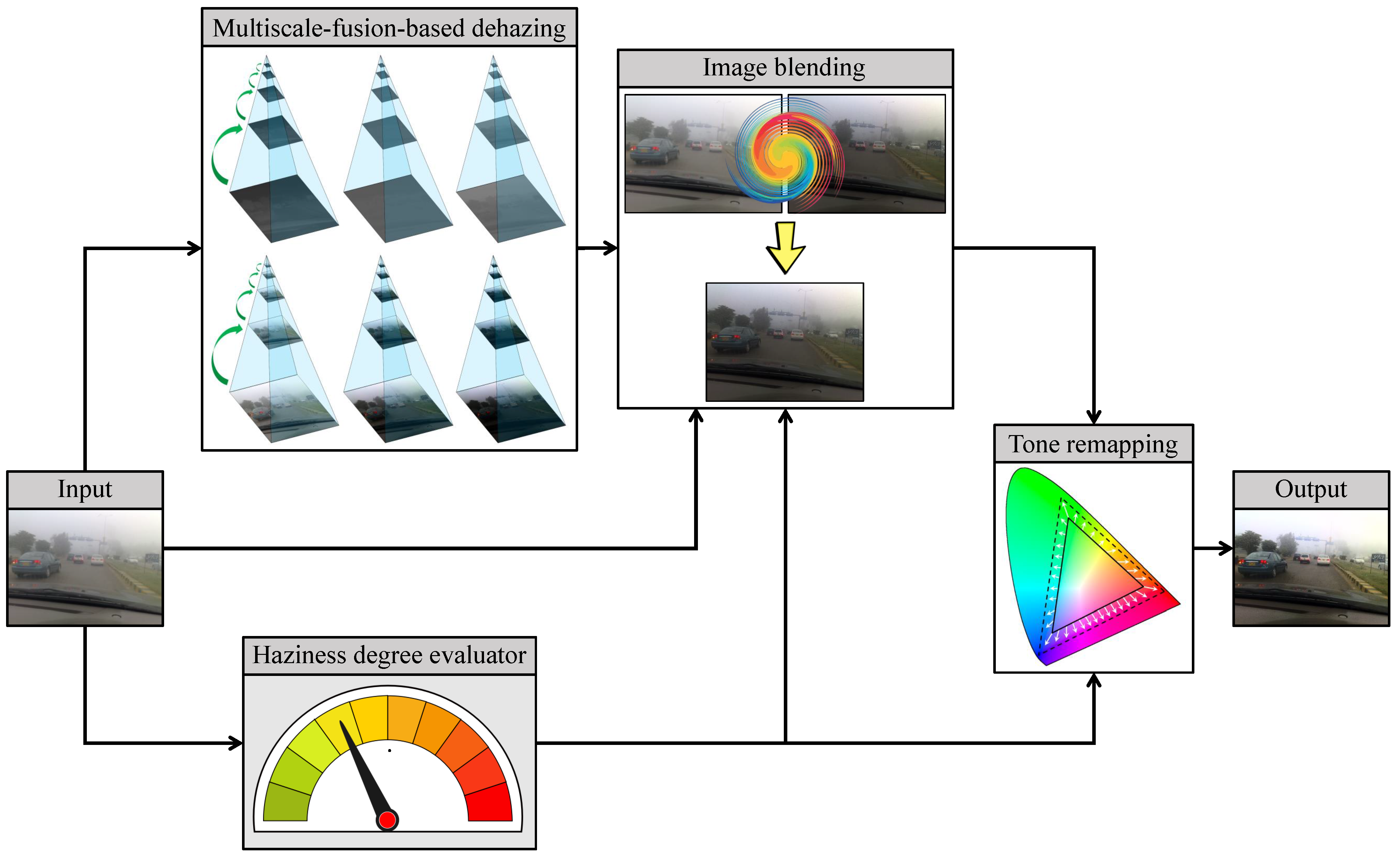
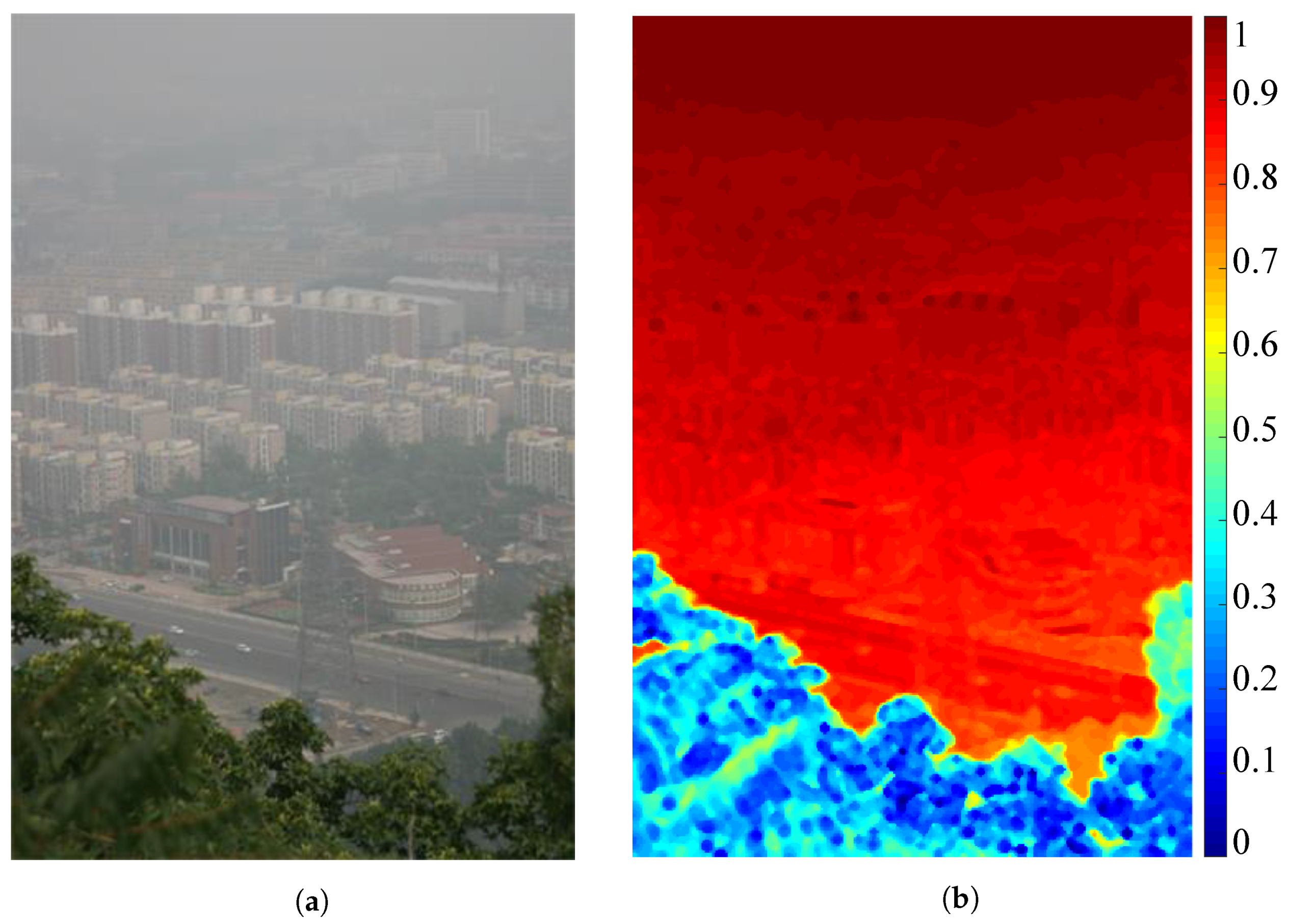

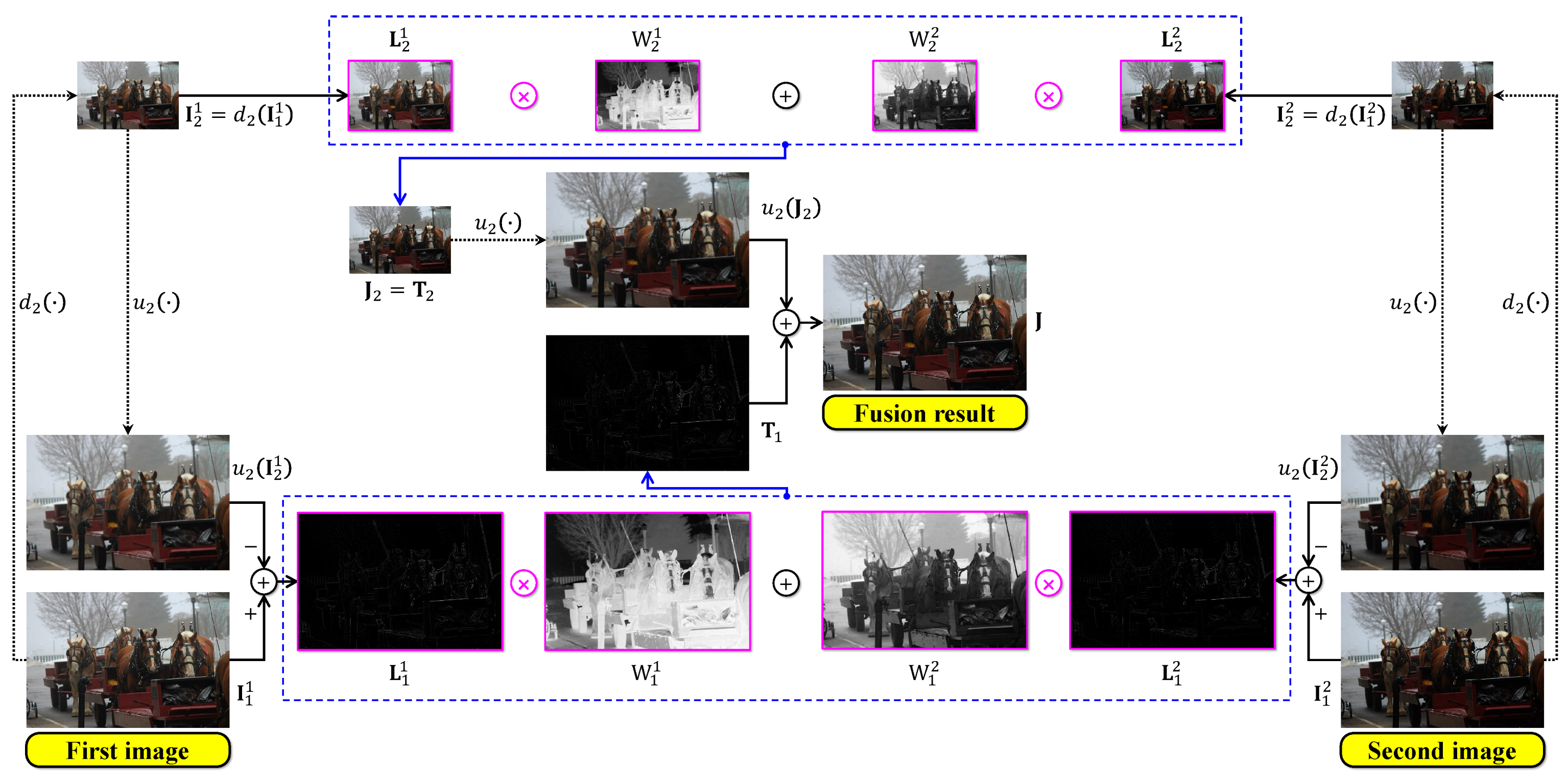
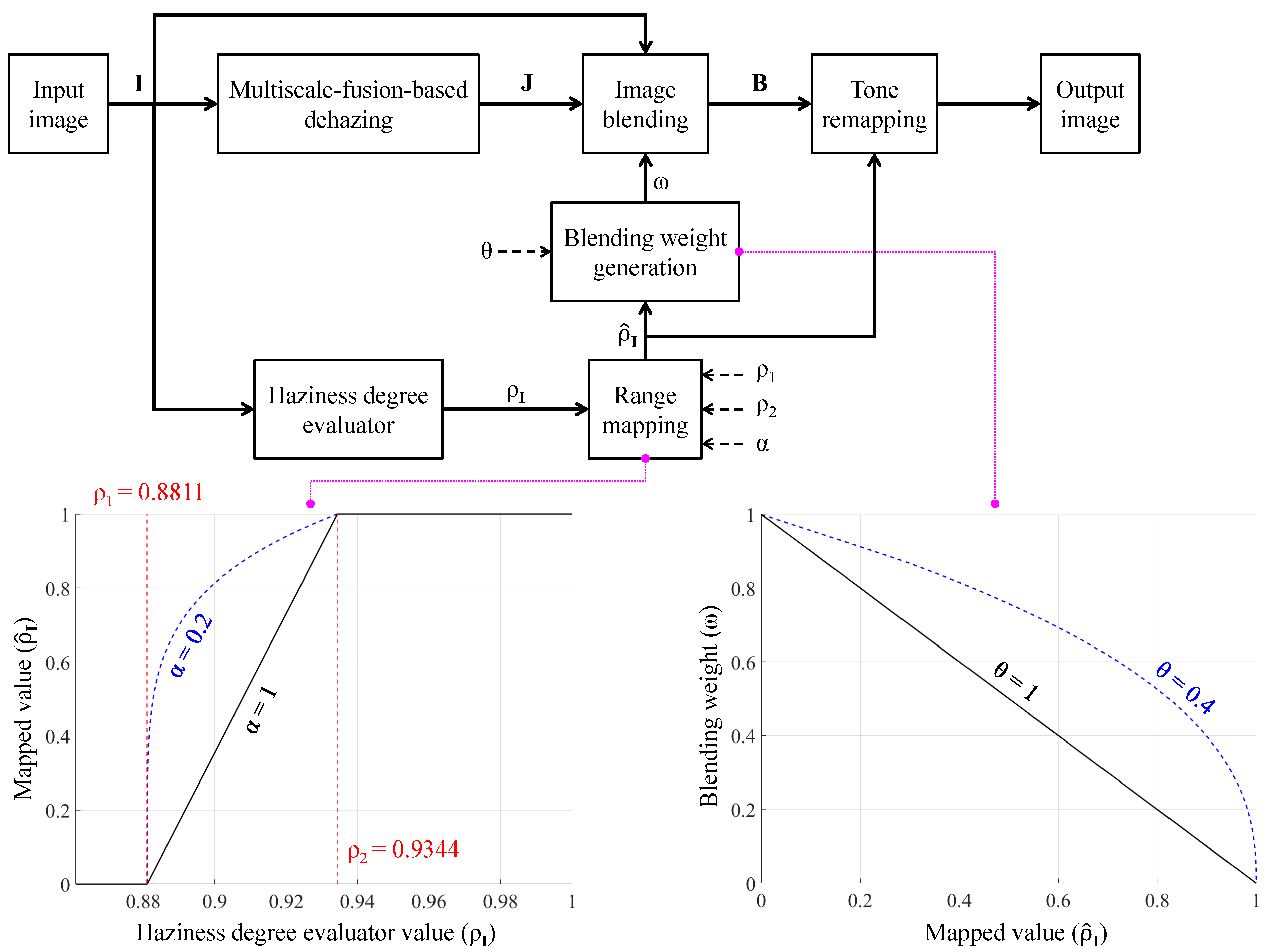

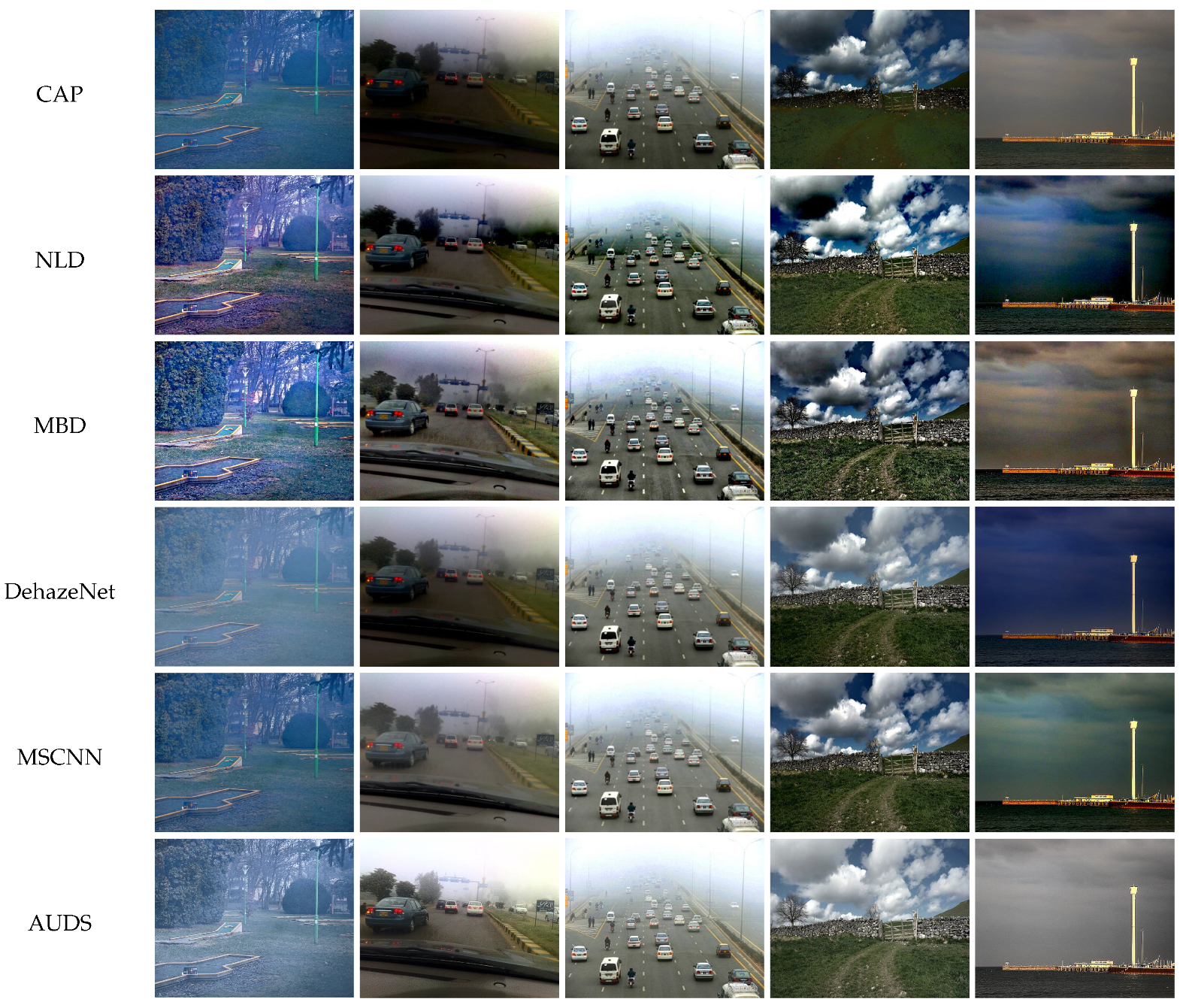

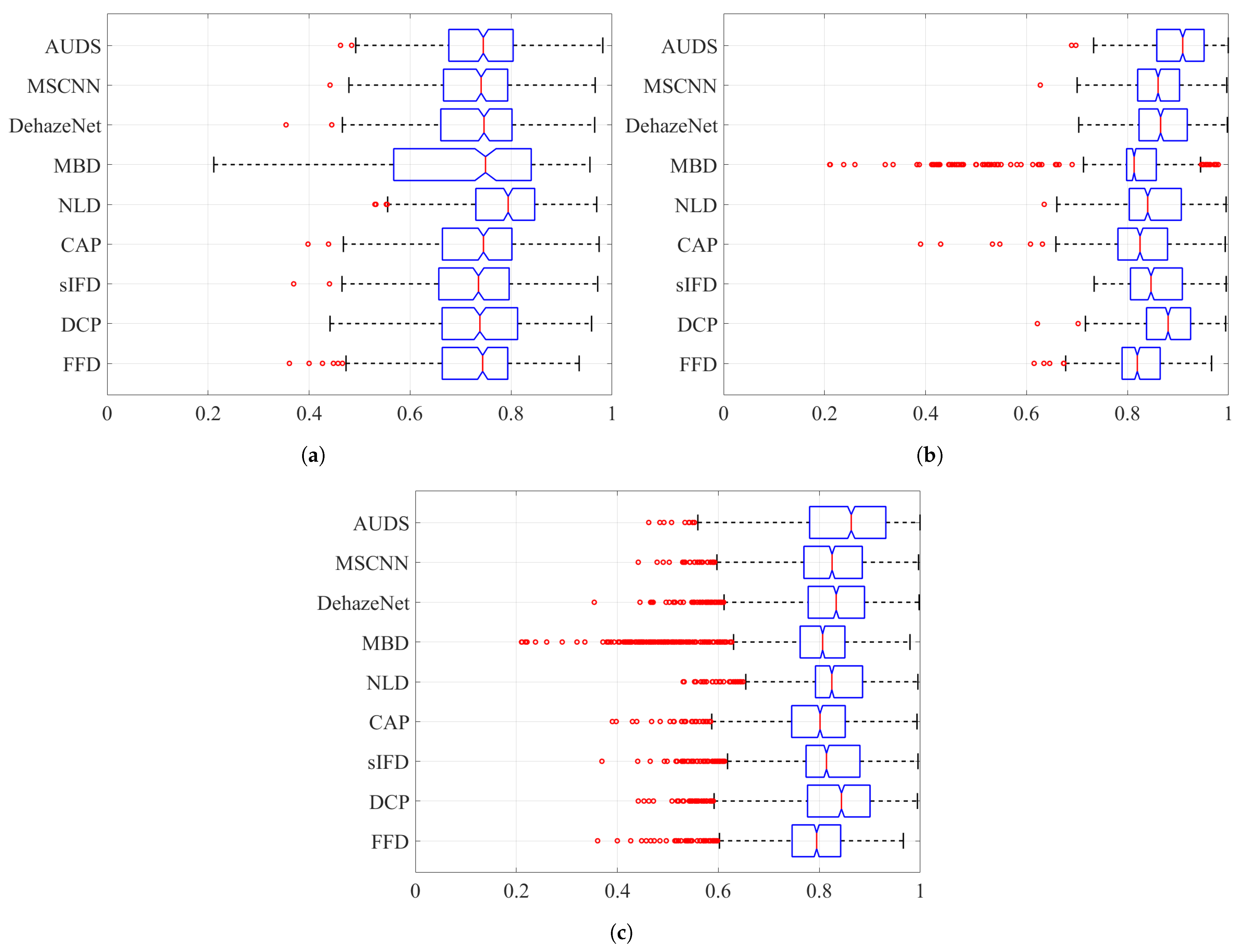
| Dataset | Type | Hazy Images (#) | Haze-Free Images (#) | Ground Truth |
|---|---|---|---|---|
| IVC | Real | 25 | NA | No |
| FRIDA2 | Synthetic | 264 | 66 | Yes |
| D-HAZY | Synthetic | 1472 | 1472 | Yes |
| O-HAZE | Real | 45 | 45 | Yes |
| I-HAZE | Real | 30 | 30 | Yes |
| FINEDUST | Real | 30 | NA | No |
| 500IMG | Real | NA | 500 | No |
| Dense-Haze | Real | 55 | 55 | Yes |
| Proposed by | Abbreviation | Description |
|---|---|---|
| Tarel and Hautiere [16] | FFD | Fast filtering operation |
| He et al. [4] | DCP | Dark channel prior |
| Ngo et al. [39] | sIFD | Single-scale image fusion |
| Zhu et al. [11] | CAP | Color attenuation prior |
| Berman et al. [26] | NLD | Non-local haze-line prior |
| Cho et al. [25] | MBD | Multi-band decomposition |
| Cai et al. [27] | DehazeNet | Convolutional neural network |
| Ren et al. [46] | MSCNN | Multiscale convolutional neural network |
| Component | Parameters | Empirical Values | Description |
|---|---|---|---|
| Multiscale-fusion-based dehazing | K | 8 | Number of artificially under-exposed images |
| Scaling factor generation in sharpness enhancement | |||
| Gamma values in artificial under-exposure | |||
| N | Equation (4) | Number of scales in multiscale fusion | |
| Patch size for weight map calculation | |||
| Haziness degree evaluator | Regularization coefficient | ||
| Emphasis strength for intensity emphasis | |||
| Patch size | |||
| Image blending and tone remapping | Thresholds for range mapping | ||
| Coefficient controlling range mapping curve | |||
| Coefficient controlling weight generation curve |
| Method | FFD | DCP | sIFD | CAP | NLD | MBD | DehazeNet | MSCNN | AUDS | ||||||||||
|---|---|---|---|---|---|---|---|---|---|---|---|---|---|---|---|---|---|---|---|
| Dataset | FSIMc | TMQI | FSIMc | TMQI | FSIMc | TMQI | FSIMc | TMQI | FSIMc | TMQI | FSIMc | TMQI | FSIMc | TMQI | FSIMc | TMQI | FSIMc | TMQI | |
| FRIDA2 | Hazy | 0.7807 | 0.7314 | 0.7746 | 0.7291 | 0.7995 | 0.7227 | 0.7918 | 0.7385 | 0.7323 | 0.7727 | 0.6792 | 0.6512 | 0.7963 | 0.7336 | 0.8009 | 0.7232 | 0.7988 | 0.7263 |
| Haze-free | 0.8566 | 0.9329 | 0.9586 | 0.9680 | 0.9574 | 0.9912 | 0.9102 | 0.8832 | 0.8770 | 0.9502 | 0.6668 | 0.5003 | 0.9703 | 0.8716 | 0.9656 | 0.9024 | 0.9971 | 0.9202 | |
| D-HAZY | Hazy | 0.8703 | 0.8000 | 0.9002 | 0.8631 | 0.8640 | 0.7775 | 0.8880 | 0.8206 | 0.8395 | 0.8435 | 0.8316 | 0.7946 | 0.8874 | 0.7966 | 0.8822 | 0.8023 | 0.8685 | 0.7710 |
| Haze-free | 0.8672 | 0.8877 | 0.9541 | 0.9123 | 0.9518 | 0.9131 | 0.8968 | 0.8829 | 0.8681 | 0.9078 | 0.8281 | 0.8758 | 0.9843 | 0.9073 | 0.9497 | 0.9075 | 0.9941 | 0.9097 | |
| O-HAZE | Hazy | 0.7733 | 0.8416 | 0.8423 | 0.8403 | 0.8350 | 0.8991 | 0.7738 | 0.8118 | 0.8605 | 0.8915 | 0.8504 | 0.8605 | 0.7865 | 0.8413 | 0.8553 | 0.8737 | 0.8530 | 0.8983 |
| Haze-free | 0.8379 | 0.8172 | 0.9645 | 0.8765 | 0.9192 | 0.8337 | 0.8679 | 0.7906 | 0.8253 | 0.8134 | 0.8158 | 0.8088 | 0.9839 | 0.8562 | 0.9369 | 0.8513 | 1.0000 | 0.9324 | |
| I-HAZE | Hazy | 0.8055 | 0.7740 | 0.8208 | 0.7319 | 0.8583 | 0.8077 | 0.8252 | 0.7512 | 0.8823 | 0.8326 | 0.8607 | 0.8161 | 0.8482 | 0.7598 | 0.8631 | 0.7819 | 0.8786 | 0.8200 |
| Haze-free | 0.8283 | 0.8380 | 0.9335 | 0.8106 | 0.9555 | 0.8911 | 0.8716 | 0.7681 | 0.8608 | 0.8565 | 0.8324 | 0.8466 | 0.9751 | 0.8343 | 0.9724 | 0.8543 | 0.9983 | 0.8979 | |
| Dense-Haze | Hazy | 0.5598 | 0.5627 | 0.6419 | 0.6383 | 0.5628 | 0.5886 | 0.5773 | 0.5995 | 0.7169 | 0.7108 | 0.6867 | 0.6843 | 0.5573 | 0.5723 | 0.6029 | 0.6176 | 0.6148 | 0.6438 |
| Haze-free | 0.8571 | 0.8440 | 0.9414 | 0.8611 | 0.9455 | 0.8771 | 0.8508 | 0.7742 | 0.8339 | 0.8346 | 0.8237 | 0.8398 | 0.9776 | 0.8539 | 0.9693 | 0.8632 | 0.9973 | 0.9171 | |
| 500IMG | Haze-free | 0.8645 | 0.8138 | 0.9563 | 0.8858 | 0.9366 | 0.8488 | 0.8795 | 0.8438 | 0.8855 | 0.8523 | 0.8605 | 0.8337 | 0.9870 | 0.8775 | 0.9383 | 0.8605 | 0.9990 | 0.8971 |
| Total | Hazy | 0.7573 | 0.7294 | 0.7746 | 0.7357 | 0.7799 | 0.7326 | 0.7693 | 0.7336 | 0.7608 | 0.7856 | 0.7228 | 0.6979 | 0.7725 | 0.7312 | 0.7896 | 0.7341 | 0.7900 | 0.7432 |
| Haze-free | 0.8621 | 0.8293 | 0.9548 | 0.8802 | 0.9399 | 0.8597 | 0.8798 | 0.8297 | 0.8764 | 0.8564 | 0.8378 | 0.8063 | 0.9840 | 0.8730 | 0.9449 | 0.8652 | 0.9986 | 0.9034 | |
| Overall | 0.8170 | 0.7863 | 0.8886 | 0.8272 | 0.8812 | 0.8131 | 0.8392 | 0.7944 | 0.8340 | 0.8304 | 0.7964 | 0.7665 | 0.9063 | 0.8209 | 0.8879 | 0.8171 | 0.9220 | 0.8446 | |
| Resolution | ||||||
|---|---|---|---|---|---|---|
| Method | ||||||
| FFD | 0.28 | 0.59 | 0.76 | 1.51 | 9.02 | |
| DCP | 12.64 | 19.94 | 32.37 | 94.25 | 470.21 | |
| sIFD | 0.26 | 0.39 | 0.64 | 1.68 | 7.18 | |
| CAP | 0.22 | 0.34 | 0.55 | 1.51 | 6.39 | |
| NLD | 2.65 | 5.54 | 6.61 | 5.74 | 34.39 | |
| MBD | 0.51 | 0.66 | 1.24 | 3.60 | 11.62 | |
| DehazeNet | 1.53 | 2.39 | 3.88 | 10.68 | 47.35 | |
| MSCNN | 0.54 | 0.88 | 1.53 | 3.43 | 17.90 | |
| AUDS | 0.65 | 1.12 | 1.88 | 4.94 | 20.36 | |
Publisher’s Note: MDPI stays neutral with regard to jurisdictional claims in published maps and institutional affiliations. |
© 2021 by the authors. Licensee MDPI, Basel, Switzerland. This article is an open access article distributed under the terms and conditions of the Creative Commons Attribution (CC BY) license (https://creativecommons.org/licenses/by/4.0/).
Share and Cite
Ngo, D.; Lee, S.; Lee, G.-D.; Kang, B. Automating a Dehazing System by Self-Calibrating on Haze Conditions. Sensors 2021, 21, 6373. https://doi.org/10.3390/s21196373
Ngo D, Lee S, Lee G-D, Kang B. Automating a Dehazing System by Self-Calibrating on Haze Conditions. Sensors. 2021; 21(19):6373. https://doi.org/10.3390/s21196373
Chicago/Turabian StyleNgo, Dat, Seungmin Lee, Gi-Dong Lee, and Bongsoon Kang. 2021. "Automating a Dehazing System by Self-Calibrating on Haze Conditions" Sensors 21, no. 19: 6373. https://doi.org/10.3390/s21196373
APA StyleNgo, D., Lee, S., Lee, G.-D., & Kang, B. (2021). Automating a Dehazing System by Self-Calibrating on Haze Conditions. Sensors, 21(19), 6373. https://doi.org/10.3390/s21196373









